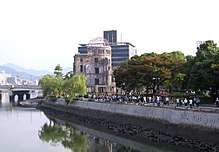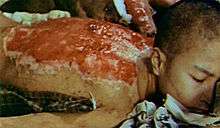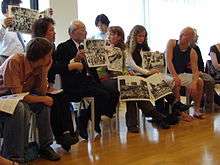Hibakusha

Hibakusha (被爆者) is the Japanese word for the surviving victims of the 1945 atomic bombings of Hiroshima and Nagasaki. The word literally translates as "explosion-affected people" and is used to refer to people who were exposed to radiation from the bombings.
Official recognition
The Atomic Bomb Survivors Relief Law defines hibakusha as people who fall into one or more of the following categories: within a few kilometers of the hypocenters of the bombs; within 2 km of the hypocenters within two weeks of the bombings; exposed to radiation from fallout; or not yet born but carried by pregnant women in any of these categories.[1] The Japanese government has recognized about 650,000 people as hibakusha. As of March 31, 2018, 154,859 were still alive, mostly in Japan.[2] The government of Japan recognizes about 1% of these as having illnesses caused by radiation.[3] Hibakusha are entitled to government support. They receive a certain amount of allowance per month, and the ones certified as suffering from bomb-related diseases receive a special medical allowance.[4]
The memorials in Hiroshima and Nagasaki contain lists of the names of the hibakusha who are known to have died since the bombings. Updated annually on the anniversaries of the bombings, as of August 2018, the memorials record the names of almost 495,000 hibakusha; 314,118 in Hiroshima[5] and 179,226 in Nagasaki.[6]


In 1957, the Japanese Parliament passed a law providing for free medical care for hibakusha. During the 1970s, non-Japanese hibakusha who suffered from those atomic attacks began to demand the right for free medical care and the right to stay in Japan for that purpose. In 1978, the Japanese Supreme Court ruled that such persons were entitled to free medical care while staying in Japan.[7][8]
Korean survivors
During the war, Japan brought many Korean conscripts to both Hiroshima and Nagasaki to work as slaves. According to recent estimates, about 20,000 Koreans were killed in Hiroshima and about 2,000 died in Nagasaki. It is estimated that one in seven of the Hiroshima victims was of Korean ancestry.[9] For many years, Koreans had a difficult time fighting for recognition as atomic bomb victims and were denied health benefits. However, most issues have been addressed in recent years through lawsuits.[10]
Japanese American survivors
It was a common practice before the war for American Issei, or first-generation immigrants, to send their children on extended trips to Japan to study or visit relatives. More Japanese immigrated to the U.S. from Hiroshima than from any other prefecture, and Nagasaki also sent a high number of immigrants to Hawai'i and the mainland. There was, therefore, a sizable population of American-born Nisei and Kibei living in their parents' hometowns of Hiroshima and Nagasaki at the time of the atomic bombings. The actual number of Japanese Americans affected by the bombings is unknown – although estimates put approximately 11,000 in Hiroshima city alone – but some 3,000 of them are known to have survived and returned to the U.S. after the war.[11]
A second group of hibakusha counted among Japanese American survivors are those who came to the U.S. in a later wave of Japanese immigration during the 1950s and 1960s. Most in this group were born in Japan and migrated to the U.S. in search of educational and work opportunities that were scarce in post-war Japan. Many were "war brides", or Japanese women who had married American men related to the U.S. military's occupation of Japan.[11]
As of 2014, there are about 1,000 recorded Japanese American hibakusha living in the United States. They receive monetary support from the Japanese government and biannual medical checkups with Hiroshima and Nagasaki doctors familiar with the particular concerns of atomic bomb survivors. The U.S. government provides no support to Japanese American hibakusha.[11]
Other foreign survivors
While one British Commonwealth citizen[12][13][14][15][16] and seven Dutch POWs (two names known)[17] died in the Nagasaki bombing, at least two POWs reportedly died postwar from cancer thought to have been caused by the atomic bomb.[18][19] One American POW, Joe Kieyoomia, was in Nagasaki at the time of the bombing but survived, reportedly having been shielded from the effects of the bomb by the concrete walls of his cell.[20]
Double survivors
People who suffered the effects of both bombings are known as nijū hibakusha in Japan.
A documentary called Twice Survived: The Doubly Atomic Bombed of Hiroshima and Nagasaki was produced in 2006. The producers found 165 people who were victims of both bombings, and the production was screened at the United Nations.[21]
On March 24, 2009, the Japanese government officially recognized Tsutomu Yamaguchi (1916–2010) as a double hibakusha. Tsutomu Yamaguchi was confirmed to be 3 kilometers from ground zero in Hiroshima on a business trip when the bomb was detonated. He was seriously burnt on his left side and spent the night in Hiroshima. He got back to his home city of Nagasaki on August 8, a day before the bomb in Nagasaki was dropped, and he was exposed to residual radiation while searching for his relatives. He was the first officially recognized survivor of both bombings.[22] Tsutomu Yamaguchi died at the age of 93 on January 4, 2010, of stomach cancer.[23]
Discrimination

Hibakusha and their children were (and still are) victims of severe discrimination when it comes to prospects of marriage or work[24] due to public ignorance about the consequences of radiation sickness, with much of the public believing it to be hereditary or even contagious.[25] This is despite the fact that no statistically demonstrable increase of birth defects/congenital malformations was found among the later conceived children born to survivors of the nuclear weapons used at Hiroshima and Nagasaki, or found in the later conceived children of cancer survivors who had previously received radiotherapy.[26][27][28] The surviving women of Hiroshima and Nagasaki, that could conceive, who were exposed to substantial amounts of radiation, went on and had children with no higher incidence of abnormalities/birth defects than the rate which is observed in the Japanese average.[29][30]
Studs Terkel's book The Good War includes a conversation with two hibakusha. The postscript observes:
There is considerable discrimination in Japan against the hibakusha. It is frequently extended toward their children as well: socially as well as economically. "Not only hibakusha, but their children, are refused employment," says Mr. Kito. "There are many among them who do not want it known that they are hibakusha."
— Studs Terkel (1984), The Good War.[31]
The Japan Confederation of A- and H-Bomb Sufferers Organizations (日本被団協 Nihon Hidankyō) is a group formed by hibakusha in 1956 with the goals of pressuring the Japanese government to improve support of the victims and lobbying governments for the abolition of nuclear weapons.[32]
Some estimates are that 140,000 people in Hiroshima (38.9% of the population) and 70,000 people in Nagasaki (28.0% of the population) died in 1945, but how many died immediately as a result of exposure to the blast, heat, or due to radiation, is unknown. One Atomic Bomb Casualty Commission report discusses 6,882 people examined in Hiroshima, and 6,621 people examined in Nagasaki, who were largely within 2000 meters from the hypocenter, who suffered injuries from the blast and heat but died from complications frequently compounded by acute radiation syndrome(ARS), all within about 20–30 days.[33][34]
In the rare cases of survival for individuals who were in utero at the time of the bombing and yet who still were close enough to be exposed to less than or equal to 0.57 Gy, no difference in their cognitive abilities was found, suggesting a threshold dose for pregnancies below which, no life-limiting issues arise. In 50 or so children who survived the gestational process and were exposed to more than this dose, putting them within about 1000 meters from the hypocenter, Microcephaly was observed, this is the only elevated birth defect issue observed in the Hibakusha, occurring in approximately 50 in-utero individuals who were situated less than 1000 meters from the bombings.[35][36]
For those who did not suffer ARS, or who survived it. In a strictly dependent manner dependent on their distance from the hypocenter, in the 1987 Life Span Study, conducted by the Radiation Effects Research Foundation, a statistical excess of 507 cancers, of undefined lethality, were observed in 79,972 hibakusha who had still been living between 1958–1987 and who took part in the study.[37]
An epidemiology study by the RERF estimates that from 1950 to 2000, 46% of leukemia deaths and 11% of solid cancers, of unspecified lethality, could be due to radiation from the bombs, with the statistical excess being estimated at 200 leukemia deaths and 1,700 solid cancers of undeclared lethality.[38]
Health
People
- Hiroshima Maidens – 25 young women who had surgery in the US after the war
- Hubert Schiffer – Jesuit priest at Hiroshima
- Isao Harimoto – ethnic Korean baseball player born in Hiroshima
- Issey Miyake – clothing designer
- Joe Kieyoomia – an American Navajo prisoner of war who survived both the Bataan Death March and the Nagasaki bombing
- Julia Canny - Irish nun who survived Hiroshima and aided survivors
- Keiji Nakazawa – author of Barefoot Gen
- Koko Kondo – notable peace activist and daughter of Reverend Kiyoshi Tanimoto
- Masaru Kawasaki – composer of the Dirge performed at every Hiroshima Peace Memorial Ceremony since 1975
- Sadako Sasaki – well known for her attempt to fold a thousand origami cranes in order to cure herself of leukemia
- Shigeaki Mori – a historian of allied prisoners of war
- Sumiteru Taniguchi – bared his scars and photos of his wounds to advocate against nuclear weapons as member of Japan Confederation of A- and H-Bomb Sufferers Organizations
- Sunao Tsuboi – teacher and activist with Japan Confederation of A- and H-Bomb Sufferers Organizations
- Takashi Nagai – doctor and author of The Bells of Nagasaki
- Terumi Tanaka – activist with Japan Confederation of A- and H-Bomb Sufferers Organizations
- Tsutomu Yamaguchi – the only person officially recognized to have survived both the Hiroshima and Nagasaki atomic bombings
Representations
- Hiroshima (1946 book)
- Hiroshima Notes (ヒロシマ・ノート, Hiroshima nôto), 1965 Ooe K.
- Children of Hiroshima (1952 film)
- Black Rain (1965 novel)
- Barefoot Gen (1973 manga series)
- Sadako and the Thousand Paper Cranes (1977 non-fiction children's book)
- No More Hiroshima (1984 documentary film)
- Hiroshima Witness (1986 documentary film)
- Debu Hiroshima ("Ashes of Hiroshima", 1987 Malaysian novel co-written by Othman Puteh and survivor Abdul Razak Abdul Hamid)[39]
- Black Rain (1989 Japanese film)
- Rhapsody in August (1991 Japanese film)
- Hiroshima (1995 film)
- Letters from the End of the World (2001 book)
- Hiroshima Diary (2005 novel)
- Town of Evening Calm, Country of Cherry Blossoms (2003 manga, 2007 novel and film)
- Hiroshima (2005 documentary/docudrama film)
- White Light/Black Rain: The Destruction of Hiroshima and Nagasaki (2007 documentary film)
- Atomic Wounds (2008 documentary film)
- Boushi (2008 TV drama)
- Carl Randall (UK artist who met and painted portraits of Hibakusha in Hiroshima, 2006/09)[40][41]
- Burnt Shadows (2009 novel shortlisted for the Orange Prize)
- Hibakusha (2012 animated short film)
- Hibakusha (2015 short story)[42][43]
- Als die Sonne vom Himmel fiel (2015 documentary film by Japanese–Swiss filmmaker Aya Domenig)[44]
- Nagasaki: Life After Nuclear War ( 2015 book by Susan Southard)
See also
References
- ↑ "Overseas Atomic Bomb Survivors Support Program". Atomic Bomb Survivors Affairs Division Health And Welfare Department Nagasaki prefectural Government. Archived from the original on 2007-09-30. Retrieved 2007-08-25.
- ↑ "Mayor vows to pass on Hiroshima history / Ceremony marks 73rd anniversary of bombing". The Japan News. August 6, 2018. Retrieved 2018-08-09.
- ↑ "Relief for A-bomb victims". The Japan Times. 2007-08-15. Archived from the original on 2007-10-11. Retrieved 2007-10-02.
- ↑ "30 A-bomb survivors apply for radiation illness benefits". The Japan Times. Retrieved 2007-08-25.
- ↑ "Hiroshima mayor questions nuclear nations' nationalism, wants Japan to do more". The Mainichi. August 6, 2018. Retrieved 2018-08-09.
- ↑ "Nagasaki marks 73rd anniversary of atomic bombing". The Japan News. August 9, 2018. Retrieved 2017-08-09.
- ↑ US diplomatic cable reporting the ruling
- ↑ My Life: Interview with former Hiroshima Mayor Takashi Hiraoka, Part 10, Chugoku Shimbun
- ↑ Mikiso Hane (2001). Modern Japan: A Historical Survey. Westview Press. ISBN 0-8133-3756-9.
- ↑ Hibakusha: A Korean's fight to end discrimination toward foreign A-bomb victims Archived 2013-02-19 at Archive.is, Mainichi Daily News. May 9, 2008.
- 1 2 3 Wake, Naoko. "Japanese American Hibakusha", Densho Encyclopedia. Retrieved Aug 5, 2014.
- ↑ "Nagasaki memorial adds British POW as A-bomb victim". The Japan Times. August 9, 1945. Retrieved Jan 9, 2009.
- ↑ This reference also lists at least three other POWS who died on 9-8-1945
- ↑ "CWGC: Casualty Details". Cwgc.org. Retrieved Jan 9, 2009.
- ↑ "CWGC: Casualty Details". Cwgc.org. Retrieved Jan 9, 2009.
- ↑ does not tell if these were Nagasaki casualties
- ↑ "Two Dutch POWs join Nagasaki bomb victim list". The Japan Times. August 9, 1945. Archived from the original on December 20, 2005. Retrieved Jan 9, 2009.
- ↑
- ↑ It Gave Him Life – It Took It, Too United States Merchant Marine.org website
- ↑ "How Effective Was Navajo Code? One Former Captive Knows", News from Indian Country, August 1997.
- ↑ "Twice Bombed, Twice Survived: Film Explores Untold Stories from Hiroshima & Nagasaki". Columbia University. August 2, 2006. Retrieved 2009-03-31.
- ↑ Japan Confirms First Double A-Bomb Survivor
- ↑ "Man who survived two atom bombs dies". CNN. January 8, 2010. Retrieved 2010-01-08.
- ↑ Simons, Lewis M. (June 7, 1984). "Children of Hiroshima, Nagasaki survivors facing prejudice, discrimination in Japan". Ottawa Citizen. Knight-Rider News. Retrieved 29 January 2016.
- ↑ "Prejudice haunts atomic bomb survivors". Japan Times. Archived from the original on 2007-08-10. Retrieved 2007-08-25.
- ↑ http://jama.ama-assn.org/content/268/5/661.short The Children of Atomic Bomb Survivors: A Genetic Study. 1992. No differences were found (in frequencies of birth defects, stillbirths, etc), thus allaying the immediate public concern that atomic radiation might spawn an epidemic of malformed children.
- ↑ http://apps.who.int/iris/bitstream/10665/78218/1/9789241505130_eng.pdf World Health Organization report. page 23 & 24 internal
- ↑ Winther, J. F.; Boice, J. D.; Thomsen, B. L.; Schull, W. J.; Stovall, M.; Olsen, J. H. (1 January 2003). "Sex ratio among offspring of childhood cancer survivors treated with radiotherapy". Br J Cancer. 88 (3): 382–387. doi:10.1038/sj.bjc.6600748. PMC 2747537. PMID 12569380 – via www.nature.com.
- ↑ http://www.rerf.jp/radefx/genetics_e/birthdef.html (RERF)Radiation Effects Research Foundation. Formerly known as the (ABCC)Atomic Bomb Casualty Commission.
- ↑ "NUCLEAR CRISIS: Hiroshima and Nagasaki cast long shadows over radiation science".
- ↑ Terkel, Studs (1984). The Good War. Random House. p. 542.
- ↑ "Welcome to HIDANKYO". Japan Confederation of A- and H-Bomb Sufferers Organization (Nihon Hidankyo) website. Retrieved 2007-08-31.
- ↑ Latest Knowledge on Radiological Effects: Radiation Health Effects of Atomic Bomb Explosions and Nuclear Power Plant Accidents
- ↑ Medical Effects Of Atomic Bombs The Report Of The Joint Commission For The Investigation Of The Effects Of The Atomic Bomb In Japan Volume 1
- ↑ Kalter, Harold (28 July 2010). "Teratology in the Twentieth Century Plus Ten". Springer Science & Business Media – via Google Books.
- ↑ Effect of Exposure to the Atomic Bombs on Pregnancy Termination in Hiroshima and Nagasaki (1956) doi.org/10.17226/18776
- ↑ Effects of Ionizing Radiation: Atomic Bomb Survivors and Their Children ... edited by Leif E. Peterson, Seymour Abrahamson. Table 7.3
- ↑ "Frequently Asked Questions #2". Radiation Effects Research Foundation. Retrieved March 2, 2014.
- ↑ Lim, Fifi (4 August 1988). "Survivor Haji Razak Recalls The Horror Of It All". New Straits Times. Universiti Sains Malaysia. Archived from the original on 21 February 2015. Retrieved 17 August 2013.
- ↑ Hibakusha Portraits, The Daiwa Anglo-Japanese Foundation, London, 2012
- ↑ Carl Randall Bio, www.carlrandall.com, London, 2012
- ↑ Hibakusha, Eastlit, 2015
- ↑ Hiroshima's Walking Ghosts, Groove Magazine, Korea, p. 53, 2015
- ↑ Stefania Summermatter and Christian Raaflaub (2015-08-13). "Als die Sonne vom Himmel fiel: Hiroshima: "Wer nicht dabei war, wird es nie verstehen können"" (in German). swissinfo.ch. Retrieved 2015-08-14.
Further reading
- Terkel, Studs, The Good War, Random House:New York, 1984. ISBN 0-394-53103-5
- Hersey, John, Hiroshima, A.A. Knopf: New York, 1985. ISBN 0-679-72103-7
External links
- Nagasaki Archive
- White Light/Black Rain official website (film)
- Voices of the survivors from Hiroshima and Nagasaki
- Voice of Hibakusha "Eye-witness accounts of the bombing of Hiroshima"
- Hibakusha, fifteen years after the bomb (CBC TV news report)
- Virtual Museum "Hibakusha testimonies, coupled with photographs, memoirs and paintings, give a human face to the tragedy of the A-bombing. Starting in 1986, the Hiroshima Peace Culture Foundation initiated a project to record hibakusha giving testimonies on video. In each year since, the testimonies of 50 people have been recorded and edited into 20-minute segments per person"
- The Voice of Hibakusha
- Atomic Bomb Casualty Commission ABCC
- Radiation Effects Research Foundation website
- "Survival in Nagasaki."
- "Living with a double A-bomb surviving parent."
- "Fight against the A-bomb."
- "Contribute actively to peace."
- Hibakusha Testimonies – Online reprints of published sources including excerpts from the Japan Times.
- Hibakusha Stories "Initiative of Youth Arts New York in partnership with Peace Boat, the Hiroshima Peace Culture Foundation, the United Nations Office for Disarmament Affairs, and New York Theatre Workshop."
- A-Bomb Survivors: Women Speak Out for Peace – Online DVD Testimonies of Hiroshima and Nagasaki Hibakusha with subtitles in 6 different languages.
